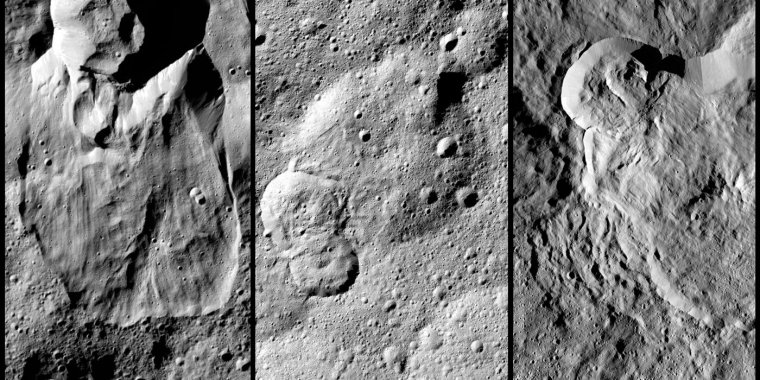| News / Science News |
Landslides on Ceres Reflect Ice Content
As NASA's Dawn spacecraft continues exploring Ceres, evidence mounts that the enigmatic dwarf planet retains a significant amount of water ice.

NASA's Dawn spacecraft has revealed many landslides on Ceres, which researchers interpret to have been shaped by a significant amount of water ice. Shown are examples of Type I (left), Type II (middle) and Type III (right). ![]()
Images from Dawn show that landslides, many of which are similar to those seen on Earth, are very common on Ceres, and further the case that Ceres has a lot of water ice involved in its structure.
There are three types of landslides. Type I, which are relatively round and large, have thick "toes" at their ends. They look similar to rock glaciers and icy landslides on Earth. Type I landslides are mostly found at high latitudes on Ceres, which is also where the most ice is thought to reside just beneath the surface, suggesting they involve the most ice of any of the flow features. Three small Type 1 flows are found in Oxo Crater, a tiny bright crater in the northern hemisphere that hosts an ice deposit at the surface.
Type II features are often thinner and longer than Type I, and are the most common type of landslide on Ceres. The landslide deposits appear similar to those left behind by avalanches seen on Earth.
Ceres' Type III features may involve a brief melting of some of the ice within the soil-like regolith, causing the material to flow like mud before refreezing. These landslides are always associated with large impact craters, and may have formed when an impact event melts subsurface ice on Ceres. These features have similar appearances to ejected material from craters in the icy regions of Mars and on Jupiter's moon Ganymede.
The locations of these different types of features reinforces the idea that the shallow subsurface of Ceres is a mixture of ice and rock, and that ice is most plentiful near the surface at the poles. (NASA)
YOU MAY ALSO LIKE


